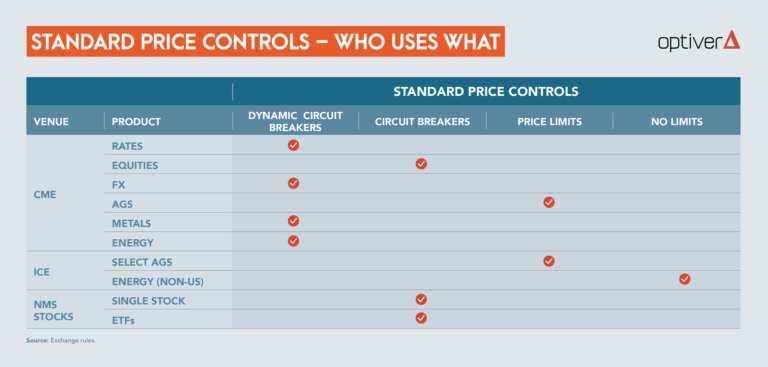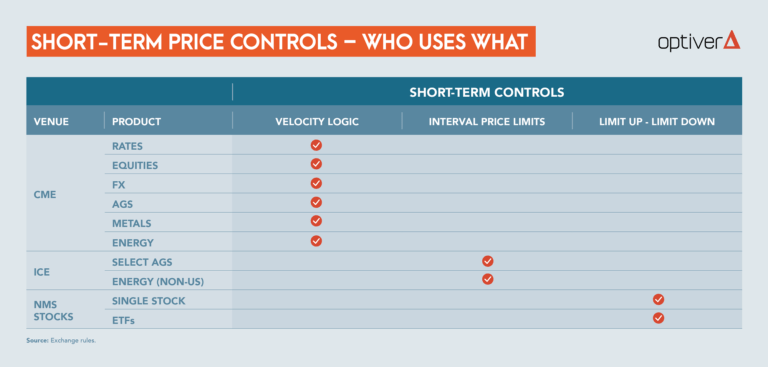An illustrated guide to price controls on US exchanges

Well-designed price controls are key to preserving orderly and efficient markets. Given their complexity, we present this overview of the various mechanisms in place across U.S. exchanges.
A volatile start to trading this year is adding a new phrase to many investors’ vocabularies: price controls. Introduced in the wake of 1987’s Black Monday stock-market crash, exchanges use price limits to prevent extreme swings from derailing orderly trading. Many market participants will remember the successive circuit breakers that hit U.S. stocks in March 2020. More recently, the London Metal Exchange (LME) adopted price controls to curb wild fluctuations in nickel, while the Chicago Mercantile Exchange (CME) modified its price limits for wheat in response to volatility.

Well-designed price controls are key in our view to preserving orderly and efficient markets by ensuring that prices don’t move too far, too fast. While they exist for virtually all exchange-traded instruments, price controls can vary widely, even on the same exchange (see tables). The existence of short-term controls such as velocity logic and limit up-limit down, which curb moves over extremely brief time periods, add to the intricacy.


Given their complexity and recent discussions about the importance of these mechanisms, we present this overview of the various tools in play.
Standard Price Controls
We can divide price controls into two broad categories: standard and short-term. Standard price controls aim to limit moves relative to the previous session’s settlement price or a rolling lookback window. U.S. exchanges use three types of standard controls.
- Dynamic Circuit Breakers. These controls suspend trading whenever prices breach an upper or lower bound (e.g., +/- 5%) that is set relative to a rolling lookback window, for instance high and low prices over the previous 60 minutes. A dynamic circuit breaker in the futures market triggers a matching halt in the associated options market. Examples of instruments that use dynamic circuit breakers are rates, FX, metals and energy products traded on the CME.
- Circuit Breakers. These are similar to dynamic circuit breakers, but use percentage thresholds set with reference to the previous session’s settlement price. Circuit breakers trigger progressively serious responses when breached. In the S&P 500 Index for instance, declines of 7% and 13% trigger 15-minute pauses, while a decline of 20% closes the market for the day (with some exceptions). The National Market System (NMS), which includes the major stock exchanges, uses circuit breakers for single stocks, exchange-traded funds (ETFs) and their associated options. Stock index futures listed on the CME follow the same rules.
- Price Limits. Instruments that use price limits become ‘locked’ whenever they fluctuate by more than a fixed dollar amount from the previous session’s settlement price. Trading continues, but market participants can’t transact at prices beyond this range for the rest of the session. Associated options can continue to trade at prices outside this range. Agricultural commodities traded on the CME such as wheat, and select agricultural products on the Intercontinental Exchange (ICE) such as cotton, canola and orange juice, use price limits.
Short-Term Price Controls
Exchanges also use price controls to limit moves over very short periods of time – sometimes as brief as a few seconds.
- Velocity Logic. Exchanges suspend trading if prices have moved by more than a predetermined number of increments over a brief period (usually a few seconds). Once triggered, the market moves into a pre-open state. In a pre-open state, orders can be entered, modified or canceled, but there’s no order matching. The CME uses velocity logic to limit short-term swings in all of its products, including rates, FX, equities and commodities instruments.
- Interval Price Limits. A hold period is triggered when prices move by more than a predetermined amount over a few seconds. During the hold period, the market cannot trade outside this range. ICE uses interval price limits for its products, including for agricultural commodities and non-U.S. energy products.
- Limit Up – Limit Down. The NMS uses this tool, which sets a percentage range for how much an instrument can move based on a preceding five-minute window. Single stocks, ETFs and their associated options follow limit up – limit down rules.
Further Reading
- Our LinkedIn Pulse post on daily price limits in wheat futures.
- Our paper on market-wide circuit breakers.
- An FAQ from the CME on dynamic circuit breakers.
- An article about LME raising its daily price limit for nickel trading.
Optiver supports open discussion and debate on all market structure topics that would lead to an improvement of the market.
To discuss this paper – or any other market structure topic – reach out to the Optiver Corporate Strategy team at [email protected]





